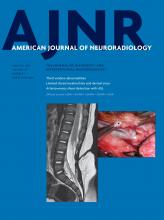Abstract
BACKGROUND AND PURPOSE: DTI is an MR imaging measure of brain tissue integrity. Little is known regarding the long-term longitudinal evolution of lesional and nonlesional tissue DTI parameters in multiple sclerosis and the present study examines DTI evolution over 4 years.
MATERIALS AND METHODS: Twenty-one patients with multiple sclerosis were imaged for up to 48 months after starting natalizumab therapy. Gadolinium-enhancing lesions at baseline, chronic T2 lesions, and normal-appearing white matter were followed longitudinally. T2 lesions were subclassified as black holes and non-black holes. Within each ROI, the average values of DTI metrics were derived by using Analysis of Functional Neuro Images software. The longitudinal trend in DTI metrics was estimated by using a mixed-model regression analysis.
RESULTS: A significant increase was observed for axial diffusivity (P < .001) in gadolinium-enhancing lesions and chronic T2 lesions during 4 years. No significant change in radial diffusivity either in normal-appearing white matter or lesional tissue was observed. The evolution of axial diffusivity was different in gadolinium-enhancing lesions (P < .001) and chronic T2 lesions (P = .02) compared with normal-appearing white matter.
CONCLUSIONS: An increase in axial diffusion in both gadolinium-enhancing lesions and T2 lesions may relate to the complex evolution of chronically demyelinated brain tissue. Pathologic changes in normal-appearing white matter are likely more subtle than in lesional tissue and may explain the stability of these measures with DTI.
ABBREVIATIONS:
- AD
- axial diffusivity
- BH
- black hole(s)
- FA
- fractional anisotropy
- GAD
- gadolinium-enhancing lesion
- MD
- mean diffusivity
- NAWM
- normal-appearing white matter
- NBH
- non-black hole(s)
- RD
- radial diffusivity
- © 2017 by American Journal of Neuroradiology
Indicates open access to non-subscribers at www.ajnr.org












